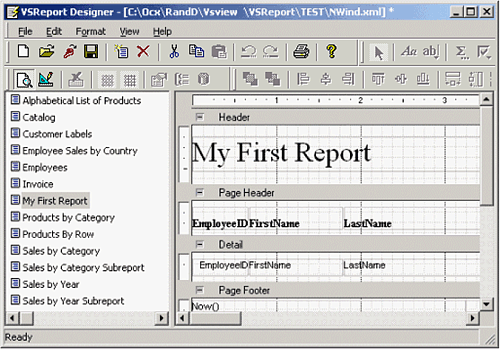Creating a Report in Design Mode
The New Report
Wizard is used to specify a data source and a basic framework
for the report. To get exactly the report you want, you can adjust and
enhance the data fields and layout. The Report Designer provides the options
to modify the report to fit your needs.
To use the Report Designer design mode
In the EFT Server administration interface, click
the Reports tab, then do one of the following:
The report appears in the Report Designer.
The left pane of the Report Designer lists all report
templates contained in the current report definition file. Click the
report that you want to modify, then click the Design
 icon
on the View toolbar, or on the main menu,
click View > Design.
The right pane switches from Review mode to Design mode, and displays
the controls and fields that make up the report.
icon
on the View toolbar, or on the main menu,
click View > Design.
The right pane switches from Review mode to Design mode, and displays
the controls and fields that make up the report.

The Report Sections
The report is divided into sections, labeled Header,
Page Header, Detail,
and Page Footer, containing fields that hold
the labels, variables, and expressions that you want in the generated
report. The sections determine the appearance of the beginning and end
of the report, and each page and group. The table below describes where
each section appears in the report and the sort of data that typically
appears in each section.
Section |
Appears |
Typically Contains |
Page Header |
Once per report |
The report title and summary
information for the whole report |
Page Header |
Once per page |
Labels that describe detail
fields and/or page numbers |
Group Header |
Once per group |
Fields that identify the
current group and possibly aggregate values for the group (e.g.
total, percentage of the grand total) |
Detail |
Once per record |
Fields containing data from
the source record set |
Group Footer |
Once per group |
Aggregate values for the
group |
Page Footer |
Once per page |
Page number, page count,
date printed, report name |
Report Footer |
Once per report |
Summary information for the
entire report |
You cannot directly add and delete sections - the number of sections
in a report determines the number of groups. Every report has exactly
five fixed sections (Report Header/Footer, Page Header/Footer, and Detail)
plus two sections per group (a Header and a Footer).
To hide sections that you do not want to display
Right-click the field, click Properties.
The Field Properties dialog box appears.
Change the property of Visible
to False.
To resize a section
Click and hold the border of the section and drag
it to the position where you want it.
The rulers on the left and on top of the design dialog box show the
size of each section (excluding the page margins). You cannot make
the section smaller than the height and width required to contain
the fields in it. To reduce the size of a section beyond that, move
or resize the fields in the section first, then resize the section.
Press and hold SHIFT, then click fields to toggle
their selection status.
Press and hold CTRL, then drag the cursor to copy
a selection.
Click on the corners of a field to resize it.
Press TAB to move the selection to the next field.
Press the arrow keys to move selected fields.
Press DELETE to remove selected fields.

|
If
you make any mistakes while moving or editing the fields, click
the Undo  and
Redo and
Redo  icons. icons. |
When multiple fields are selected, you can use the buttons on the Format toolbar to align, resize, and space them.

You can control the design grid using the
Show Grid  and
Snap To Grid
and
Snap To Grid  icons.
icons.
Related
Topics
Adding,
Editing, and Deleting Fields in the Report .
Changing
Field, Section, and Report Properties
Changing the Data
Source
Adding,
Editing, and Deleting Fields in the Report
Grouping and Sorting
Data
![]() icon
on the View toolbar, or on the main menu,
click View > Design.
The right pane switches from Review mode to Design mode, and displays
the controls and fields that make up the report.
icon
on the View toolbar, or on the main menu,
click View > Design.
The right pane switches from Review mode to Design mode, and displays
the controls and fields that make up the report.